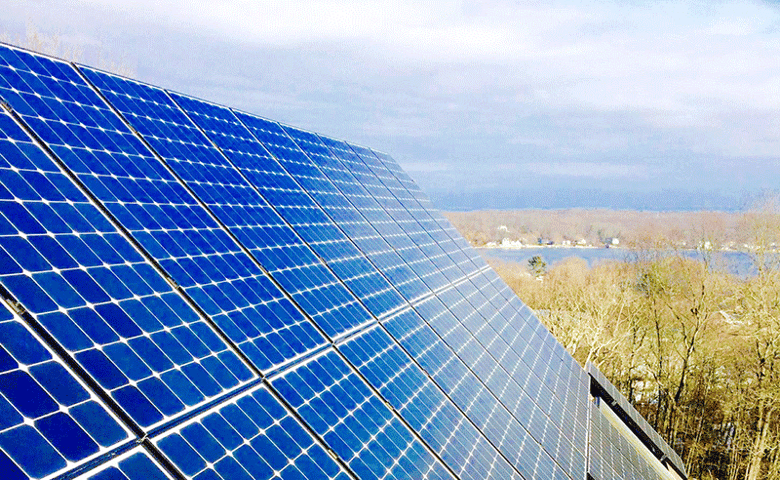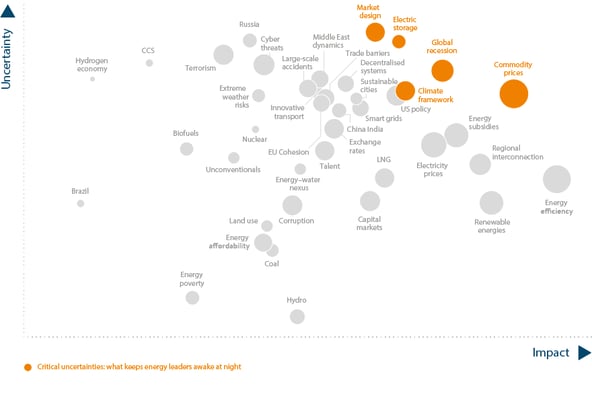
According to the 2016 World Energy Issues Monitor1, electric storage features in second place on the list of top critical uncertainties keeping CEOs, ministers and energy experts awake at night.
The role of electric storage to secure the supply of electricity is becoming ever more important as our energy sources continue to shift from fossil fuels to renewable energies.
 Orange cirlces: Critical uncertainties: what keeps energy leaders up at night. Used by permission of the World Energy Council
Orange cirlces: Critical uncertainties: what keeps energy leaders up at night. Used by permission of the World Energy Council
The good news is that sustainable energy from wind, solar and geo-thermal power plants are contributing more and more energy to the global grid; the shift towards the use of electric vehicles for ground transportation instead of cars driven by combustion engines is accelerating. If electric vehicles replaced gasoline-powered transportation, it would significantly reduce greenhouse gas emissions.
The supply of sustainable energy fluctuates during the day. This creates the need for energy storage, e.g. batteries. The goal is to develop batteries that can store sustainable energy with long term stability, in an environmentally safe way.
We’ve been talking about smaller and better batteries for a while now - ”they will charge our phones in minutes,” “cheap electric cars with a hundred-mile range will be here tomorrow,” ”cheap and reliable renewable energy storage is just around the corner.” So is it all just talk or when will this future be here?
Smartphones and other smart gadgets are growing more advanced, but they are still limited by power and the advancement of batteries hasn’t come as far. Technology companies and electric car manufacturers are painfully aware of the limitations of current batteries.
Li-ion batteries have shown great potential. They can be found today in most portable small devices and in larger more demanding applications, such as electric vehicles. Materials science researchers all over the world are working to further improve them. A spotlight is on developing new materials within the Li-ion technology to enable batteries with high energy density and a long cycle life.
This research is of great interest for industries and governments. But there are doubts. For some application areas, like transport and grid energy, Li-ion batteries are not yet economically viable. A shortage of Lithium and some of the metals used in the batteries may become an issue in the future. However, with the significant benefits outweighing the challenges, Li-ion batteries are very much in focus when it comes to portable electrochemical energy storage for the foreseeable future.
The materials used in the electrodes is a fascinating topic in itself. Electrodes with higher rate capability, higher charge capacity and (for cathodes) adequately high voltage can improve the energy and power densities of Li batteries and make them smaller and cheaper. Many anode and cathode materials are being studied, but there are many limitations such as insufficient electrical conductivity, slow Li transport, dissolution or other unwanted interactions with electrolytes, low thermal stability, high volume expansion and mechanical brittleness.
New findings and developments in the field of electrode materials will lead to more opportunities to store sustainable energy and less emissions of greenhouse gases.
Learn more about energy storage by listening to our podcast, Science on surfaces – a bigger perspective on the small. In this episode, we talk about different ways to store energy, challenges and limitations, and what the future looks like.
Learn more about Quartz Crystal Microbalance with Dissipation monitoring technology, QCM-D, from a user perspective.
The range of technologies that could be used in a biointerfaces lab is vast. We talked to Dr. Jenny Malmstrom, University of Auckland to learn more.
Light interaction with matter is an important part of our everyday lives. We talked to Prof. Magnus Jonsson at Linköping University, to learn more.
Learn about the difference between primary and secondary batteries, and about battery performance indicators.
Read about the benefits of Li-ion batteries and why the invention was awarded the Nobel prize
This is what we learned about the fascinating area of nanomedicines when we talked to Dr. Gustav Emilsson, who is working with nanomedicine development
